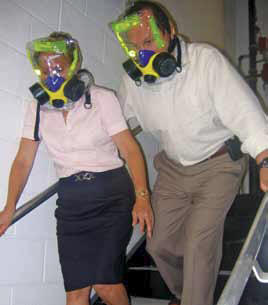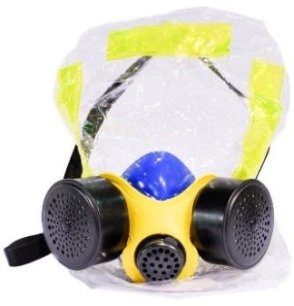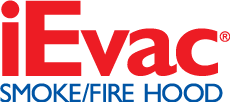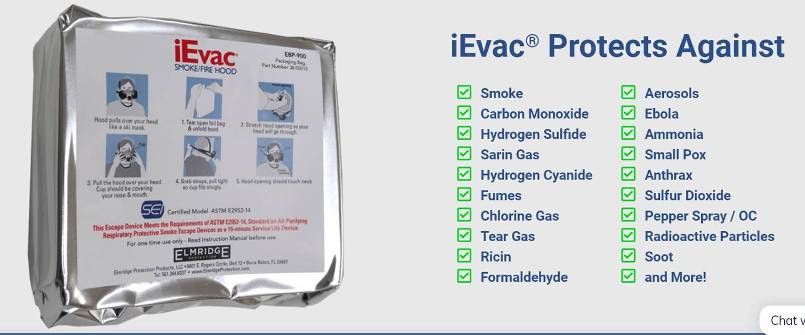GET READY FOR SURVIVAL MODE
1.877 282-7673

GET READY FOR SURVIVAL MODE




● Carbon Monoxide
●
Additional Toxic Gases - Smoke, Hydrogen Cyanide, Chlorine, Ammonia,
Sulfur Dioxide, Hydrogen Chloride, Hydrogen Sulfide, and more.
●
Harmful Particulates - soot, fumes, aerosols and others.
● Contains a
Pleated HEPA filter that removes more than 99.996% of sub-micron particles such
as anthrax, smallpox, and radioactive particles
● Life Threatening
Physical Hazards - flammability and radiant heat.
● Designated as a
Qualified Anti-Terrorism Technology by the US Dept. of Homeland
Security, office of the Safety Act
● The first hood Certified to the
American National Standard for Smoke Escape Devices

Shelf Life: 5 1/2 years
$199.99
Additional Information:
Certification
The iEvac® is certified as an
Air-Purifying Respiratory Protective Smoke Escape Device. This
certification is issued by the Safety Equipment Institute (SEI) and
certifies that iEvac® is in complete conformance with the American
National Standard for Air-Purifying Respiratory Protective Smoke Escape
Devices. This certification is earned after extensive independent
testing to prove compliance with every requirement in the Standard. This
testing was performed by Intertek and Assay
Technology
Total Performance
The iEvac® Smoke/Fire Hood has
a recorded protection factor greater than 90,000. iEvac® is a smoke
escape hood, an air purifying respiratory device for evacuation in case
of an emergency. Its overall effectiveness depends on the filters, the
nose cup and the neck dam. Each of these three integrated elements must
play a part in order for the entire hood to be protective. The overall
effectiveness is determined by a Fit Test, and is measured by checking
the performance during a series of standardized exercises. The Fit Test
result is expressed as the protection factor of the iEvac®. For
reference, OSHA has assigned a protection factor of 10 for N95 masks and
50 for rubberized full face masks. Another benchmark is the NIOSH test
requirement for CBRN APER masks (respirators for escape from toxic and
dangerous atmospheres containing chemical, biological, radiological and
nuclear hazards). NIOSH requires a protection factor of 2,000 for these
masks. The U.S. Army Research, Development and Engineering Command -
Edgewood Chemical Biological Center in Aberdeen, Maryland conducted
tests of the iEvac® using the NIOSH methods and procedures. Under these
rigorous protocols, they measured the fit test protection factor for the
iEvac® as being greater than 90,000.
ANSI 110 Total Performance Requirements
The total performance of a respirator may
be determined by calculating its total inward leakage. This is
determined by measuring the concentration of a challenge substance
outside of the respirator, the concentration within the breathing zone
and comparing the two results. Clearly, the best respirators are those
with a very low Total Inward Leakage.
The iEvac® Smoke/Fire Hood has a recorded Total Inward Leakage measured inside the nose cup of less than 0.01%. This characteristic was measured by the U.S. Army Research, Development and Engineering Command - Edgewood Chemical Biological Center in Aberdeen, Maryland. For reference, the requirement for certification to the ANSI 110 standard is that the Total Inward Leakage inside the nose cup shall not exceed 2%.
It is also important to consider the possibility of leakage through the neck seal into the hood. If this were to happen, the wearer’s eyes could be affected and vision obscured by smoke. This characteristic is different from the Total Inward Leakage which is measured inside the nose cup. This measurement taken within the hood but outside the nose cup is known as the ocular leakage. The U.S. Army Research, Development and Engineering Command - Edgewood Chemical Biological Center in Aberdeen, Maryland measured and recorded the ocular leakage of the iEvac® Smoke/Fire Hood as less than 0.1%. For reference, the requirement for certification to the ANSI 110 standard is that the ocular leakage shall not exceed 20%.
Gases
The iEvac® filters are a proprietary blend
of materials specifically formulated to be effective against a wide
range of gases and particulates. (Tests against particulates are
described below.) Probably the two most dangerous gases encountered
during an emergency escape from a fire are carbon monoxide and hydrogen
cyanide. These special filters will provide protection against both
these gases. They are designed to provide protection against these
life-threatening products of combustion and also against other toxic
industrial gases and terrorist gases.
iEvac® filters have been independently tested
against gases.
Among the tests are the following:
Particles
The iEvac® filters are a proprietary
blend of materials specifically formulated to be effective against a
wide range of particulates and gases. (Tests against gases are described
above.) In keeping with its design excellence, the iEvac® filters
contain the best possible particle filter, a high efficiency particulate
air HEPA filter. This is the same material used in military gas masks to
provide protection against biohazards. The HEPA filter will remove
99.996% of particles that are 0.2 microns in size. It is this ability of
the filters to remove sub-micron particulates that keeps out the small
particles that may be present in smoke. Also, the filters will remove
very heavy particles such as soot. During this test, the filters must
remove the soot from the air and still not clog the filters so that it
is too difficult to breathe.
Breathing Resistance
The iEvac® filters are very
protective and also designed for easy breathing. This is important in
all applications but is particularly necessary in emergency situations
when the wearer may be inclined to panic. The iEvac® is tested for both
inhalation and exhalation resistance.
Physical Hazards
Many physical hazards may be
encountered when escaping from a fire. There will be flames, heat, hot
material dripping, and other hazards. Vision will be very important, as
will the need for the packaging to stand up to vibration and puncture
threats from sharp objects.
Inhalation Temperature
It is important to
establish that the air that comes through the filters does not become
overheated by the filtration process. This is established by passing
5000 ppm carbon monoxide at a temperature of 77°F (25°C) and checking
for an increase in air temperature.
Flammability
Tests for heat and flame resistance.
During theses tests components will not have an afterflame longer than 5
seconds. No component will drip, melt or develop a visible hole or be
damaged so that eyes or lungs are exposed to smoke. These tests involve
a temperature of 1475°F (800°).
Molten drip
In this test, a flaming drip from an
ignited polypropylene rod is allowed to drop onto the hood. No after
flame lasts longer than 5 seconds.
Radiant heat
The hood is exposed to a radiant
heat panel comprising two quartz lamps with a surface temperature
between 980°F (527°C) and 1700°F (927°C) determined from a spectral
emittance curve. The hood is located 9.5 inches away from the radiant
heat panel and exposed for 15 seconds. The requirement is that the hood
is not damaged in a way that exposes eyes or lungs to gas or smoke and
that the temperature at the top of the head and inside the eyepiece
shall not exceed 158°F (70°C). The hood passed.
Putting the hood on very quickly
The hood can be
unpackaged and put on in less than 30 seconds
Optical properties
Light transmission, haze and
field of vision are all tested to make sure that the viewing area is big
enough and durable enough.
Fogging
A test is conducted to ensure that a
person can clearly read a standard eye chart while wearing the hood.
Corrosion
The hood is exposed to a corrosive salt
spray, and tested afterwards
Vibration
This test involves vibrating the
packaging for 10,000 cycles.
Puncture and tear
The package is raked by a sharp
pointed heavy striker. The packaging does not puncture, rip or tear
Operational Package Leakage
The package is
immersed in water heated to a temperature of 160°F (70°C) to a depth of
24 inches (600 mm) and must not leak.
Temperature exposure
The packaged hood is exposed
to a temperature of 32°F (0°C) for 24 hours then exposed to 180°F (70°C)
for 24 hours. Then the hood is unpacked and tested for performance.
Pressure conditioning
The packaged hood is
exposed to 100 cycles of differential pressure. Each cycle is 60 seconds
at ambient, 20 seconds going from ambient to 300 mbar below, 60 seconds
at 300 mbar below and 20 seconds back to ambient. Then the hood is
unpacked and tested for performance.
More Test Data
We are continuing to develop more
test data for the iEvac® Smoke/Fire Hood and we will add these to our
web site as they become available.
Precautions
Of course, no filter and no hood can
provide 100% protection, so be sure to follow the instructions in the
User Manual.